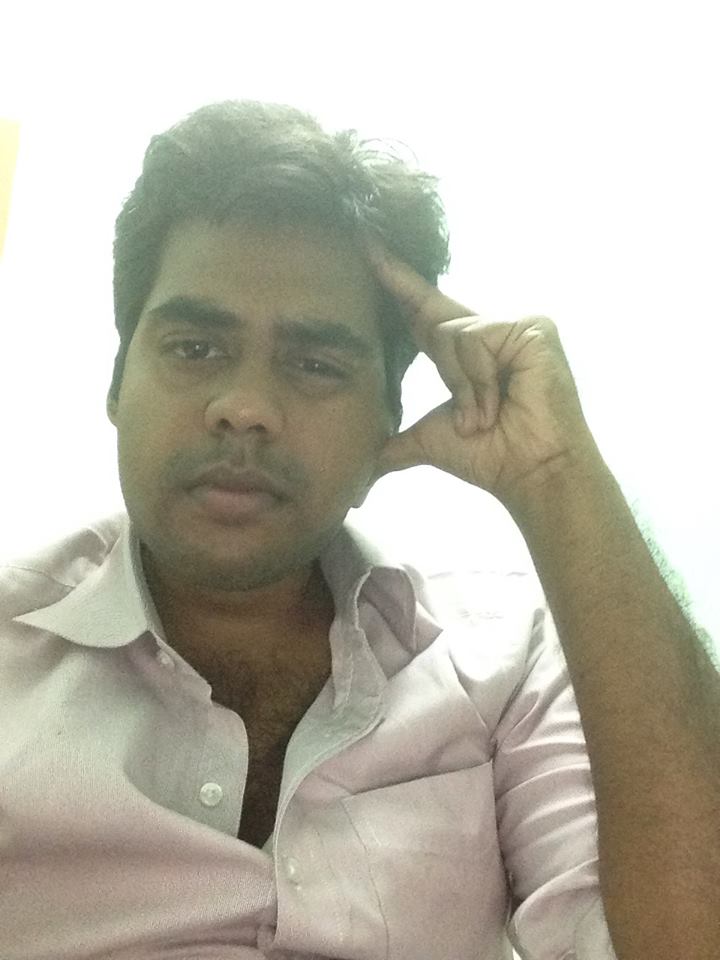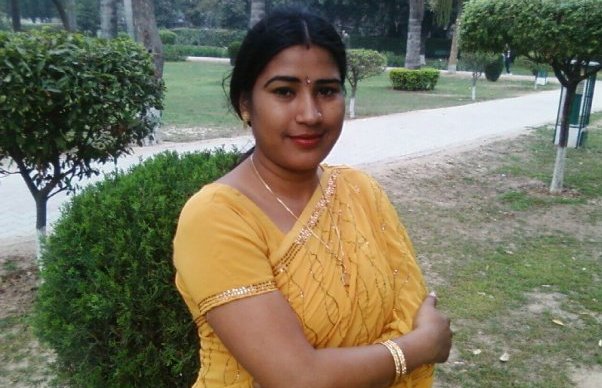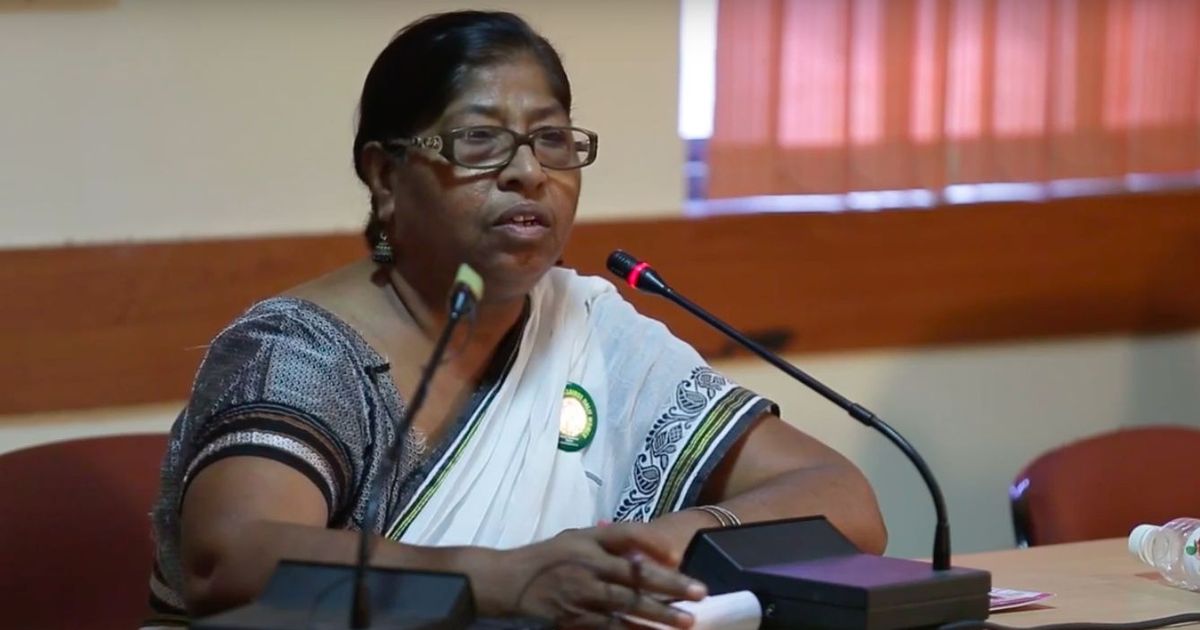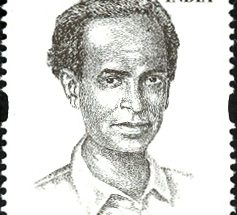Hari Prasad
 “Students of social organization have been content with noting the difference between equality and inequality. None have realized that in addition to equality and inequality there is such a thing as graded inequality….. To make the thing concrete the Brahmanic law of marriage is full of inequity. The right of Brahmana to take a woman from the classes below him but not to give a woman to them is inequity. But the Kshatriya, Vaishya and Shudra will not combine to destroy it. The Kshatriya resents this right of the Brahmana. But he will not combine with Vaishya or the Shudra and that for two reasons. Firstly because he is satisfied that if the Brahman has the right to take the right of three communities, the Kshatriya has the right to appropriate the women of two communities. He does not suffer so much as the other two. Secondly if he joins in a general revolution against this marriage-inequity in one way he will rise to the level of the Brahmins but in another way all will be equal which to him means that the Vaishyas and the Shudras will rise to his level i.e. they will claim Kshatriya women-which means he will fall to their level. Take any other inequity and think of a revolt against it. The same social psychology will show that a general rebellion against it is impossible.” (Emphasis mine)
“Students of social organization have been content with noting the difference between equality and inequality. None have realized that in addition to equality and inequality there is such a thing as graded inequality….. To make the thing concrete the Brahmanic law of marriage is full of inequity. The right of Brahmana to take a woman from the classes below him but not to give a woman to them is inequity. But the Kshatriya, Vaishya and Shudra will not combine to destroy it. The Kshatriya resents this right of the Brahmana. But he will not combine with Vaishya or the Shudra and that for two reasons. Firstly because he is satisfied that if the Brahman has the right to take the right of three communities, the Kshatriya has the right to appropriate the women of two communities. He does not suffer so much as the other two. Secondly if he joins in a general revolution against this marriage-inequity in one way he will rise to the level of the Brahmins but in another way all will be equal which to him means that the Vaishyas and the Shudras will rise to his level i.e. they will claim Kshatriya women-which means he will fall to their level. Take any other inequity and think of a revolt against it. The same social psychology will show that a general rebellion against it is impossible.” (Emphasis mine)
~ Dr. Ambedkar, Revolution and Counter Revolution in Ancient India.
The Hindu system of caste, sexuality and morality survives and respires on the avowed purity of the caste Hindu woman, whose chastity and singularity corresponds to the power and privilege of the caste Hindu man. The preservation and perseverance of endogamy built on this avowed purity sustains the hegemony of the caste system. The avowed purity is both a saddle and a privilege reciprocated on the upper caste woman whose conferred dignity, howsoever dubious, extends indifferently and despairingly to the Shudra and Ati Shudra woman. As the Hindu legal texts1 ordain the lower caste women to serve the Brahman and upper caste men, as maids and mistresses, upper caste women are identified with Strisvabhava and Stridharma in their essential role to reproduce castes, in their strict fidelity to the caste Hindu husband. Jenny Rowena, in her brilliant essay titled “The ‘dirt’ in the Dirty Picture: Caste, Gender and Silk Smitha‘ remarks thus:
“Hindu religious traditions institutionalize the use and exploitation of Dalit-Bahujan women’s bodies for the sexual pleasure and entertainment of men who are placed higher than them in the caste hierarchy. This works to legitimize various other violent forms of oppression such as rape, formal and informal workplace sexual exploitation and networks of prostitution, involving adivasi, Bahujan and dalit women. All these firmly hold down the body of the subaltern woman within a sexualized structure of abuse, violence and exploitation.
In great contrast, the caste system approaches the upper caste woman’s body in a totally different manner. It makes her body the adored and worshiped site of caste purity. The upper caste woman’s body comes to be protected/controlled by father, husband and son (Manusmriti, IX, 3) under a caste Hindu morality, based on notions of chastity, virginity and docile femininity. As a consequence of such a caste/gender differentiation, the sexual energies which are made to be brooked with regard to the upper caste female body often gets unleashed onto the figure of the subaltern woman, who becomes the favored site of male sexual pleasure, violence, entertainment and release”
It is such distinctions that manifested in the Joginis, Mathammas, Devadasis and it is on the non-brahman, lower caste women, on their suppressed humanity, that the state and society builds the Kamathipuras. Thus the conferred dignity on the caste Hindu woman, irrespective of its dubiousness has no meaning for the lower caste woman. The sexuality of upper caste women in her sati-savithri avatar and such ideals is exemplified in prime time national debate, whilst the notions of ‘impurity’ and sexual tyranny of lower-caste women kindles no emotions. The brilliant design of the caste system thus translates into different sets of axioms for the upper caste women and indifferent sets of axioms for the lower caste women. The Kiss of Love protests and the surrounding nauseating euphoria in mainstream media and academia vividly represent this brilliant design of indifference that leads us to the dialectics of morality and sexuality as represented from the extremes and medians in the caste hierarchy.
The myth of Progress
The most illustrious examples of such distinctions and indifferences are widely seen in the ‘progressive’ state of Kerala, which has kindled this prime-time national debate revolving on the constituents of morality and sexuality of (upper caste) women.
The history of Kerala, as has been the history of India has been the history of the caste system that chisels the contours of culture and politics, both past and present. Ambedkar’s theorization on ‘graded inequality’ discerns the Hindu woman in her humiliations, relative to her position in the caste hierarchy.
As one can see from the set of practices that ran for several centuries, the Nair women were made to cohabit with the Namboodiri men, indulging the latter’s private vices (Sambhandam relationships), while the Dalit-Bahujan women were forced to uncover their breasts in public view and in front of the feudal lords. As the Nair women’s humiliation was given a ceremonial treatment and a conferred dignity, the Dalit-Bahujan women were left to bear nothing but contempt. In a ranking contrast to the position of Nair and Dalit-Bahujan women, the Namboodiri women were ‘preserved’ and ‘protected’ in the Brahmin households as Antharjanams with utmost ‘purity’. It was on the ground work laid by the Nadar castes’ revolt against the forced practice of parading their women half-naked and other lower castes’ struggles for the right to dignity in the nineteenth century2 that the movements led by Ayyankali, Narayana Guru and the later interventions of Christian missionaries occurred. The revolts also gave birth to Velutha Lakshmikutty Amma’s historic struggle in the ‘Maru Marukkal’ agitation of 1952 against the forceful participation of women in the ‘Vela’ Festival with their breasts uncovered.

(Caste lords violating the honour of Avarna in public: Chanar Woman by Chitrakaran: Ajaysekher.net)
Despite the struggles and revolts of the Dalit-Bahujans, the character of ‘progressive’ Kerala has undergone little change. The land is still fertile in its humiliations of the daughters of Suryanellis. Women are barred entry to the Sabarimalai temple and exploitation of actors like Shakeela and Silk Smitha are celebrated and naturalized. It is in these caste distinctions that the sexual tyranny over Shakeela and Silk Smitha never strikes a panic, never threatens the Hindu morality; while the ideal, Antharjanam woman’s sexual freedom finds smarthavicharam, and leaves her excommunicated from the purity of her caste. Of course, it to be observed here that the sexual freedom of the Caste Hindu woman causes panic only in the event of its transgression outside the Laxman Rekha of caste-purity, relative to her caste position. In this interplay of maladies, both the savarna and avarna women suffer, albeit their suffering depends on the relative graded nature of the maladies. To say that the revolutionary character of Kerala enabled the recent discourse on morality and the ground for liberation of women is to make a farce of this country’s history, and that of the Dalit-Bahujan.
Rise of the Caste Hindu Woman
The upper caste woman benefited largely from the social reforms, starting from the pre-independence era, or what Ambedkar called the ‘reform of the Hindu family’. These reforms were much about widow-remarriage, child marriage, girl education, etc., and according to Ambedkar, it did not aim at social reorganization or reconstruction, which would have meant annihilation of caste. The upper caste Hindu woman due to her obvious proximity to the upper caste man, reaped directly from the social reforms churning out in her family. The constitutional reforms on gender parity in post-independence India were doing similar wonders for the upper caste woman. As women in the propertied classes began to enjoy their right to inheritance, the ‘right’ meant little for the property-less classes of Dalit-Bahujan.
With the advent of economic reforms in the 1990s, the upper castes stood as principal benefactors owing to their social networks, share and proximity in the power structures of this country. The Dalit-Bahujan from the same period were growingly alienated and remained to serve their upper caste masters in the new Industrial complexes under old feudal relationships3. The so-called post-liberalisation era merely strengthened the occupancy of the upper castes at the boardrooms and the bureaucracy, at the stock exchange and the newsrooms, at the IITs and IIMs, at the JNUs and DUs, as they have grown omnipotent and omnipresent in their stinking display of power and privilege.
The wedding of the foreign capital with the Indian procreated new ‘public’ spaces in the urban jungle, the likes of pubs and cafés that offer space and time for socializing, accessible at large to the privileged of the new republic. The procreation of these new age spaces stems from the social and economic upward mobility of the elite which in turn stems from the unpaid labour and discrimination of the Dalit-Bahujan4. The fear that these new spaces and such socializing could possibly provide for caste-transgressions stokes the pride and passion of the caste Hindus who react spontaneously and lividly to salvage their supposed caste pride and honour. The Hindus fear that the foreign/western capital could also bring along the western ideals of equality, liberty and fraternity, the very same ideals that they resisted when they revolted against Buddha.
The attack on the DownTown café and similar attacks by the hard-line caste Hindus lucidly checks the greater visibility of upper caste women inside these new ‘public’ spaces. This mobility and the supposed sexual freedom of the upper caste women are perceived as a direct threat to the ideal of the Antharjanam, the perceived requisite to maintain the caste order.
Victorian morality or the casteist ploy to make caste invisible
Strangely, the reactions from the occupants of these new public spaces have discounted the fundamental nature of the attacks on their exercise of freedom, that being the morality of caste. It is from here one understands the oddity of the reactions and the surrounding nauseating euphoria mentioned earlier, in the mainstream media. The discourse has been oblivious to the question of caste and more significantly, in the rhetoric of their noise, the subjectivity of the Dalit-Bahujan has been made utterly invisible. The self -and associated morality to the caste system or the Hindu religion in stricter terms.
There have been debates revolving around the IPC codes of ‘public decency’ and its origins of Victorian morality5. The attempt appears to be a clever ploy to shift the discourse and blame onto the colonial masters. It is the same ploy that is also used by the Hindus in blaming the ruthlessness of the caste system onto the colonial interventions, while reserving some usefulness for the caste system during the ‘glorious’, ancient past of their fatherland. Some ‘feminists’ have also invoked the ‘glorious past’ of Kamasutra and Rasa lila6, also conveniently forgetting the inglorious past of burning women on the husband’s pyre, the system of forced widow-hood, girl-marriage, all the three carried out as repression of the Hindu woman’s sexuality, freedom and mobility.
As observed by Ambedkar in his seminal paper, ‘Castes in India: Their Mechanism, Genesis and Development’ at Columbia University, the violent forms of repression of female sexuality was to maintain the endogamic purity. The stance of the self-procalimed ‘progressive’ ‘feminists’, and the strong defence of Hinduism and their attack on any opponents questioning or problematizing caste is much in tune with the view that attacked Buddha for the downfall of women in India. The accusation was made by Eve’s weekly in 1950, which took an Ambekdar to refute and correct. It is the same view that also charged Ambedkar with preaching modesty to women in Kamathipura, where he appealed to the community women to disown prostitution. One has to understand the ease and élan with which the so called feminists discount the question of caste and the proponents of anti-caste thought. The suggestion of Victorian morality by neo-‘progressives’ negates the centrality of caste in the suppression of Indian woman and her sexuality. It is an irony that it was the Victorian morality in the larger sense that catalysed the Nadar castes to revolt against forced uncovering of their women’s breasts in public and in their rightful claim for social dignity and self-respect.
Pitting Love against Love
“If you love without evoking love in return – if through the vital expression of yourself as a loving person you fail to become a loved person, then your love is impotent, it is a misfortune” ~ Karl Marx
The Dalit-Bahujan have suffered significantly in their ‘crime’ of love, and remain insignificant when it comes to the market place of opinions and counter opinions. The rhetoric of the self-proclaimed ‘progressive’ forces has been conspicuous in sidelining the question of caste in their celebration of love. The narrative of Divya and Ilavarasan, Vimala Devi and Dilip Kumar, and innumerous Dalit-Bahujan murdered for their ‘sin’ of love has been outrightly negated in an irony that celebrates love, in the relay protests that fight for love, in the assertion of the ‘revolutionary’ youth who vouch for the liberation of women.
As a Dalit whose voice is contained from such rapid assertion and ‘revolution’, I am aghast at the stinking display of power and privilege that the elite and upwardly mobile throw abundantly in the streets, in the new-age public spaces, in their occupancy of higher echelons of clout and influence across the instruments of the state.
“It is necessary for the servile classes to go further and find out who are likely to be the instruments of the State, in other words who is going to be the governing class… In selecting the instrumentalities of the State considerations of class bias in the instrumentalities cannot be overlooked. It is in fact fundamental to good government. It is unfortunate that the importace of this fact is not generally recognized even by those who regard themselves as the champions of democracy. Karl Marx was the first to recognize it and take account in the administration of the Paris Commune. It is necessary to say that it is today the basis of Government in Soviet Russia. The demand for reservations put forth by servile classes in India is essentially based upon the same considerations pointed out by Dicey, advocated by Marx and adopted by Russia. Only those who belong to the servile classes can be trusted to protect the interest of that class” ~ Dr. Ambedkar.
~
References
[1]. Manu:
“Kanyam bhajanti……..” – 8/364. In case women enjoy sex with a man from a higher caste, the act is not punishable. But on the contrary, if women enjoy sex with lower caste men, she is to be punished and kept in isolation.’
“Heenjati striyam……..” – 3/15. When twice born [dwij=Brahman, Kshatriya and Vaish] men in their folly marry low caste Shudra women, they are responsible for the degradation of their whole family. Accordingly, their children adopt all the demerits of the Shudra caste.
The Hindu legal texts entertain the exploitation of lower caste women’s bodies by the upper castes, however legality of any sexual relationship between the upper castes and the lower castes are resisted and punished.
[2]. James Michael in “Yesudas and I : Many hues of a Prejudice” gives a deep account of Dalit-Bahujan struggles in Kerala (http://roundtableindia.co.in/index.php?option=com_content&view=article&id=7701:yesudas-and-i-many-hues-of-a-prejudice&catid=119:feature&Itemid=132).
[3]. Urban labour Market Discrimination by Sukhdeo Thorat, Paul Attewal and Firdaus Fatima Rizvi (http://www.dalitstudies.org.in/download/wp/0901.pdf) speaks extensively about hiring, favoritisms and social exclusion or in other words casteism in the urban labour market. The executive and ‘white’ collar jobs are primarily reserved to the dominant (upper castes) castes.
Santhosh Goyal, in his work ‘Social Background of Officers in the Indian Administrative Service” presents the skewed composition of the IAS cadre that largely favours the ‘upper’ castes.
[4]. Same as [2].
[5]. Kavitha Krishnan (http://www.ndtv.com/video/player/left-right-centre/row-over-kiss-of-love-protest/343679)
[6]. J Devika (http://kafila.org/2014/11/03/challenging-the-empire-of-chicken-littles-kiss-of-love-at-kochi/)
Inspiration: Dr B R Ambedkar.
~~~
Painting courtesy: Ajaysekher.net
Hari Prasad works in a public sector bank.










